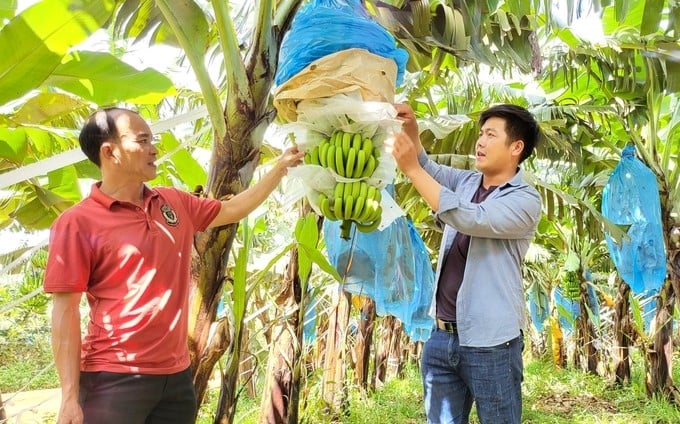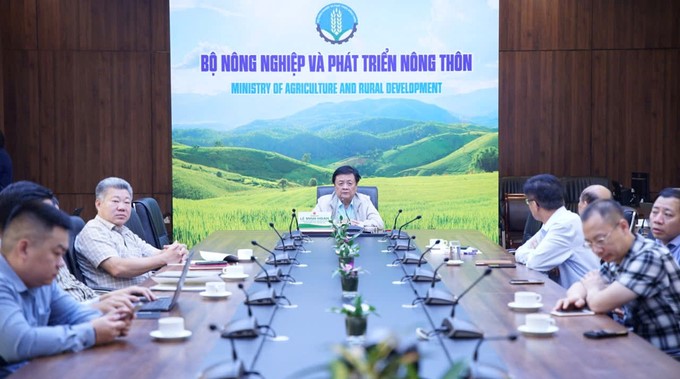June 20, 2025 | 04:26 GMT +7
June 20, 2025 | 04:26 GMT +7
Hotline: 0913.378.918
June 20, 2025 | 04:26 GMT +7
Hotline: 0913.378.918
On October 30, in Gia Lai, MARD coordinated with the Central Highlands provinces to organize a conference to promote investment in agriculture and rural areas in the Central Highlands. Minister of Agriculture and Rural Development Le Minh Hoan chaired the online conference in Hanoi.
Mr. Duong Mah Tiep, Vice Chairman of the Gia Lai Provincial People's Committee, said that the province's agricultural land area is more than 845,000 ha, mainly basalt red soil. This is very suitable for growing many types of crops with high economic value, such as pepper, coffee, rubber, sugarcane, cassava, medicinal plants, fruit trees, and livestock grass.

Conference to promote investment in agriculture and rural areas in the Central Highlands provinces. Photo: Tuan Anh.
Gia Lai also has many favorable potentials for the development of the processing industry, with 31 industrial clusters and a rich and stable source of agricultural raw materials in the area. This will create a premise for investors interested in developing the processing industry. Besides, Gia Lai has the advantage of convenient transportation and is a focal point for trade and transshipment of goods and commercial services in the development triangle of the three countries: Cambodia, Laos, and Vietnam.
"Gia Lai province is gradually promoting these favorable conditions effectively, opening the door to welcome potential investors in three strong fields: advanced, clean, and high-tech agriculture; services and ecotourism; clean, environmentally friendly industry associated with agriculture," shared Mr. Tiep.
In recent years, Hung Nhon Group and De Heus (Netherlands) have linked to deploy many high-tech agricultural projects in the Central Highlands on a large scale and achieved significant achievements.
Mr. Vu Manh Hung, Chairman of the Board of Directors of Hung Nhon Group, said that for these projects to develop smoothly, support from the local government as well as appropriate investment attraction policies are needed. Through practical implementation, businesses realize that there are still many challenges and obstacles in attracting investors into the high-tech livestock sector.
"First of all, I think localities need to have clear and consistent planning for raw material and livestock production areas. Planning needs to closely follow the potentials and have synchronization between localities, helping investors see long-term development direction while ensuring reasonable use of resources."

Agricultural products in the Central Highlands are being well received by the market. Photo: Tuan Anh.
Ms. Ha Thi Hoa, Director of Ha Bao Silk Co., Ltd. (Lam Dong province), said: "Currently, we have established a project to produce silkworm eggs and raise baby silkworms using high technology in Gia Lai province, with a scale of 300 ha and an investment of VND 600 million. We hope that Gia Lai province's departments and branches will continue to create favorable conditions for businesses to well implement investment projects."
Sharing about investment trends in Vietnam of foreign businesses, Mr. Le Hoang The, Vice Chairman of the Overseas Vietnamese Businessmen Association, said that the Central Highlands provinces have huge resources, especially the emission-reducing carbon market. This is a resource that brings very high economic value.
"After this conference, we will disseminate to Vietnamese entrepreneurs and businesses abroad about the potentials and resources of the Central Highlands provinces. We also recommend that the five Central Highlands provinces prepare more human resource training to work on declaration, inventory, verification, and certification in the field of carbon certificates. Thereby, bringing the provinces' resources to participate in this market," Mr. The shared.

Gia Lai is attracting many businesses to invest in banana growing. Photo: Tuan Anh.
Speaking at the conference, Minister of Agriculture and Rural Development Le Minh Hoan said that with innovative thinking and investment expansion of leading businesses, the Central Highlands can transform from a place focusing on growing short-term industrial crops such as rubber and coffee to attract more businesses in the livestock sector.
The Minister recommended that local governments and businesses need to have an opener and unlimited mindset for agriculture in the Central Highlands.
The Minister suggested building buffer zones for the production of animal feed and aquatic feed in areas where livestock enterprises invest with cooperatives to minimize risks from fluctuations in the input raw material market such as corn and soybeans, which are mainly imported.
The commander of the agricultural sector also said that there needs to be coordination between local governments and businesses to resolve policy problems and pledged that MARD will support within its authority.

The Minister recommended that local governments and businesses need to have an opener and unlimited mindset for agriculture in the Central Highlands. Photo: Linh Linh.
The Minister acknowledged that businesses coming to the locality not only help bring economic benefits, create jobs, and provide social security, but also contribute to community and social responsibilities.
Minister Le Minh Hoan also noted that businesses need to pay attention to the EU's European Deforestation-Free Regulations (EUDR). Although this regulation is delayed by a year, in the future, it will have a major impact on the Central Highlands’ coffee and wood export industries.
The Minister called on businesses to prepare for sustainable development and be ready to overcome trade barriers and increasingly strict technical requirements. MARD and the SPS agency are ready to provide technical information about markets for businesses.
According to the assessment of the Planning Department (Ministry of Agriculture and Rural Development), the Central Highlands currently has over 5 million ha of agricultural land. With favorable climate and soil, the Central Highlands is becoming the country’s major agricultural production center, with key crops such as coffee (over 660,000 ha), rubber (220,000 ha), pepper (77,000 ha), durian (75,000 ha), and passion fruit (nearly 7,000 ha). Along with that, the Central Highlands region has over 4 million cattle and 30 million poultry and exploits over 700,000 m3 of planted forest wood/year.
Translated by Thu Huyen
/2025/06/17/3942-2-143243_548.jpg)
(VAN) Recently, in Sweden, the Secretary of the Binh Dinh Provincial Party Committee presented the Investment Registration Certificate for the 'Polyester Fabric Recycling Complex' project to SYRE Impact-AB Company.
/2025/06/12/3721-2-202745_83.jpg)
(VAN) TH made an impression at Seoul Food 2025 with its line of natural beverages, paving the way for Vietnamese food products to enter the South Korean market.

(VAN) Soc Trang's success in rice exports stems from a strategy of developing fragrant and specialty rice cultivation areas and standardizing production toward low-emission practices.
/2025/06/11/1311-5-120811_839.jpg)
(VAN) The pig farming industry is facing the challenge of comprehensive restructuring to meet requirements for quality, safety, traceability, and market expansion both domestically and for export.

(VAN) Vietnam considers participating in ALGROALBA in order to expand agricultural production, coordinate the assessment and effective exploitation potential land.
/2025/06/05/5314-1-184727_407.jpg)
(VAN) From seemingly worthless fish scales and skin, enzymes and lactic ferments can transform by-products into peptides, opening a sustainable, effective business direction and elevating Vietnamese seafood.

(VAN) TTC AgriS and IFC signed a strategic partnership to develop a sustainable agricultural value chain, aiming to achieve the Net Zero target by 2035.